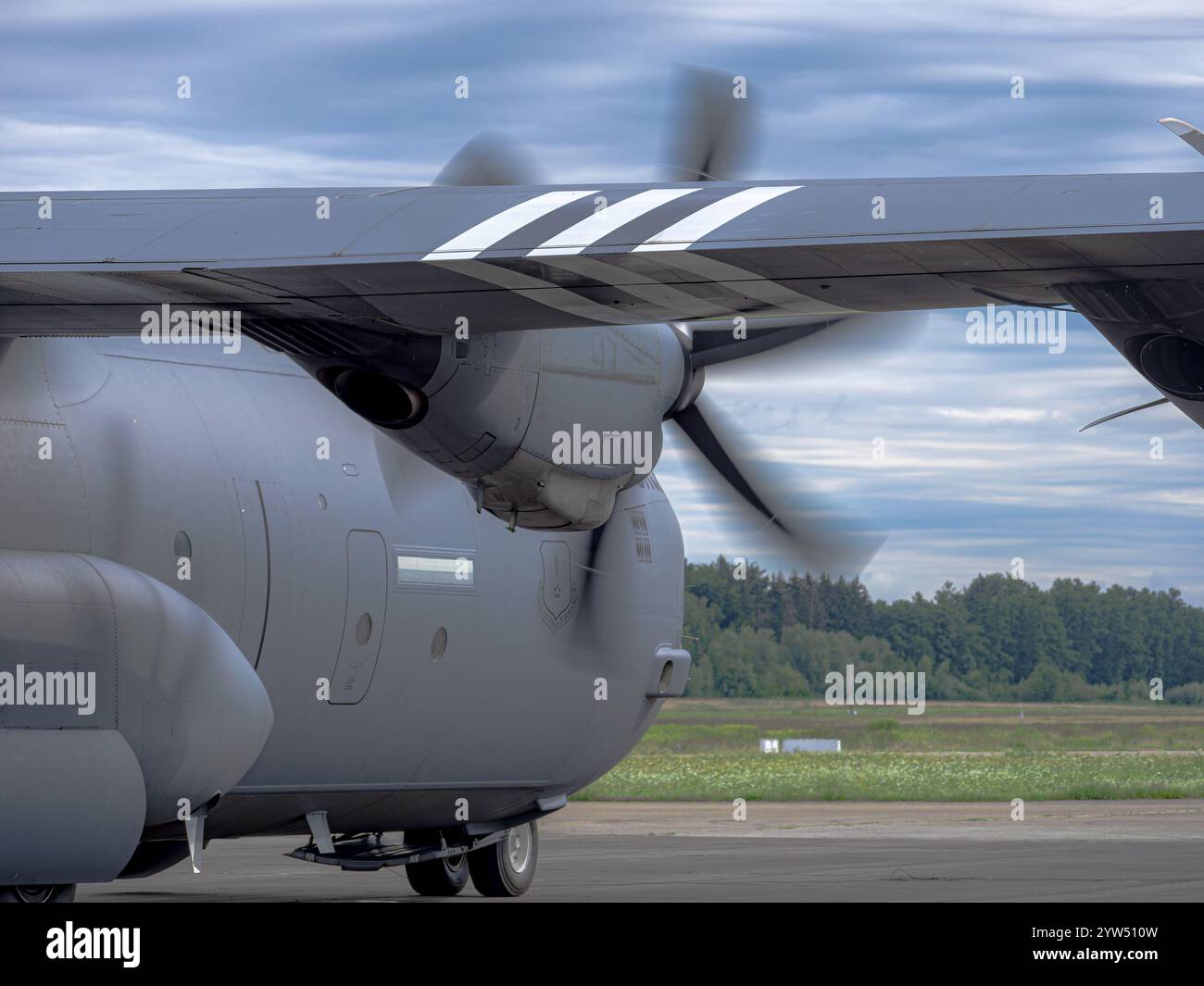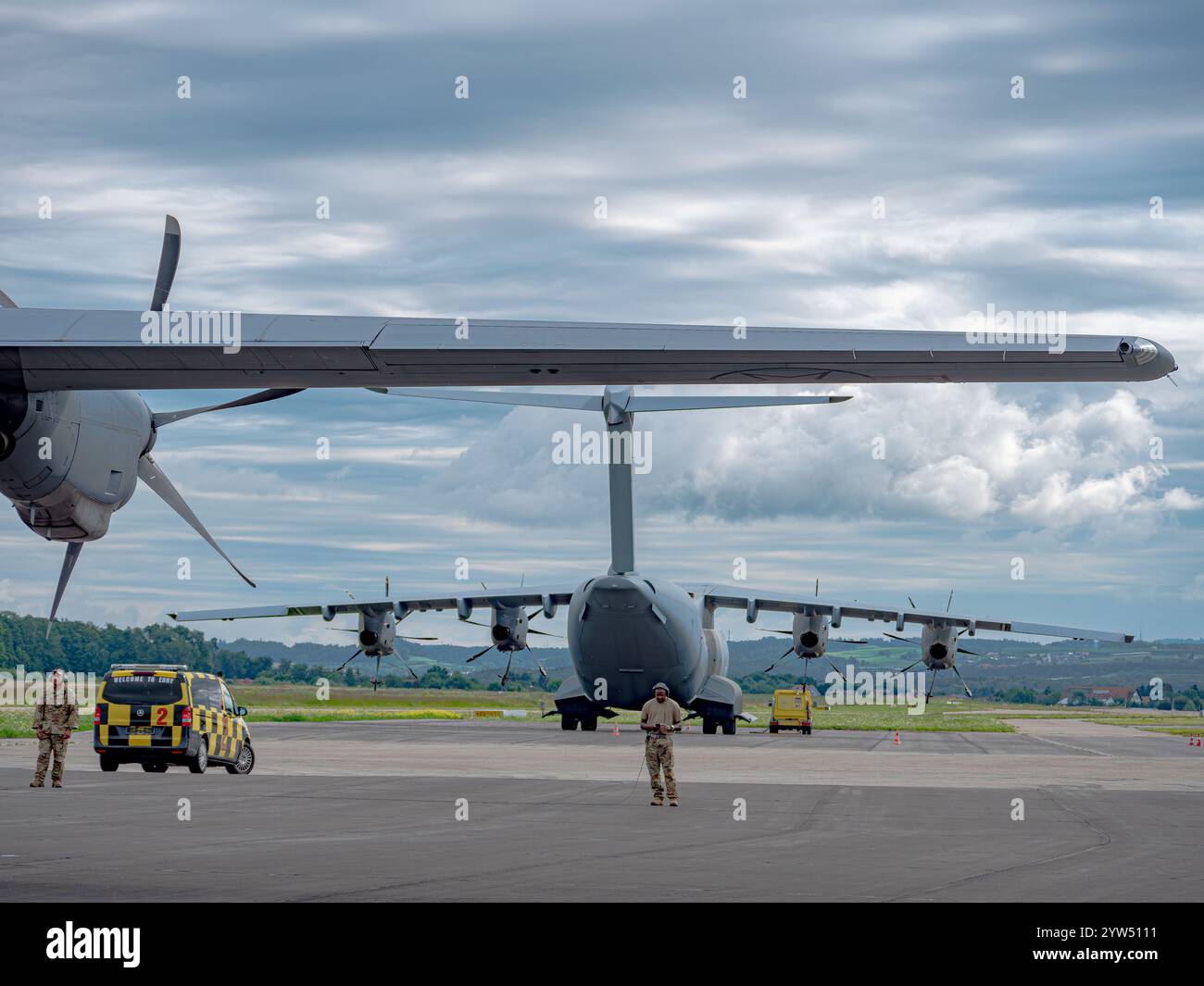There are certain machines that simply capture our imaginations, aren't there? They stand as towering symbols of human ingenuity and sheer will, pushing the boundaries of what anyone thought possible. One such machine, a true marvel of engineering and a fascinating piece of aviation history, is the H4 Hercules. You might know it better by its affectionate nickname, the "Spruce Goose," and its story is, frankly, quite unlike any other. It's a tale of ambition, a bit of controversy, and an airplane that, in a way, defied the odds just to take flight.
We are going to take a closer look at this truly unique aircraft, examining what made it so special and why, even decades later, it still sparks so much conversation among those who care about aviation. It’s a chance to really get to know a machine that was built during a time of great need, yet it became something much more than just a wartime transport. This big flying boat, made mostly of wood, has a story that feels almost legendary, you know, like something out of a very compelling book.
So, if you've ever wondered about the biggest plane ever built, or perhaps the challenges involved in creating something so grand from such unusual materials, then this guide is for you. We’re going to search into its beginnings, its one famous flight, and its lasting impact on the world of aviation. It’s a pretty interesting topic, and we'll be looking at it from several angles, just to give you a full picture.
Table of Contents
- What Exactly Was the H4 Hercules?
- How Did They Build Something So Big?
- Why Did It Only Fly Once?
- What Is the Legacy of the H4 Hercules Today?
What Exactly Was the H4 Hercules?
The H4 Hercules, often called the "Spruce Goose," is, in a way, a giant flying boat, a truly massive aircraft built during the Second World War. It was meant to carry a lot of troops and cargo across the Atlantic Ocean, away from the dangers of German U-boats. Howard Hughes, a rather famous and sometimes eccentric businessman and aviator, was the driving force behind its creation. He had this idea for a huge plane that could do what no other plane could at the time. It was supposed to be a solution, basically, to a very pressing wartime problem.
This aircraft, you see, was absolutely enormous. It had a wingspan longer than a football field, which is pretty incredible to think about. Its sheer size was, for the time, quite unheard of. The government had asked for a transport aircraft that didn't use materials that were in short supply, like aluminum, which was needed for other warplanes. So, Hughes and his team turned to wood, mostly birch, which gave it that famous "Spruce Goose" nickname, even though it wasn't actually made of spruce. It was a very bold move, to be honest, building such a big machine out of wood.
The H4 Hercules was designed as a seaplane, meaning it could take off from and land on water. This was an important feature for its intended role, as it would allow it to operate from various locations without needing long runways. It was, in some respects, a completely different approach to large-scale air transport than what was generally being pursued. The sheer ambition behind this project, from its very first sketch to its construction, really makes you stop and think about what people can achieve when they set their minds to it.
The Beginnings of the H4 Hercules: A Look into Its Creation
The story of the H4 Hercules starts in 1942, when the U.S. government needed a way to move war materials and personnel safely across the ocean. German submarines were making sea travel incredibly dangerous, so an air bridge seemed like a good idea. Henry J. Kaiser, a shipbuilder, first proposed the idea of a giant cargo plane, and he brought in Howard Hughes to help make it a reality. They secured a contract, and the work began. It was, you know, a very urgent project.
Hughes, being the perfectionist he was, took over the project entirely pretty quickly. He poured a lot of his own money and time into it, making sure every detail was just right, or at least, as he saw it. The construction process was long and filled with challenges, partly because of the sheer scale of the aircraft and partly because of the unusual materials. They had to develop new techniques for working with wood on such a grand scale. It was a massive undertaking, literally, that pushed the limits of engineering at the time.
The initial idea was to build three of these aircraft, but as the war progressed and the challenges mounted, the focus shifted to just completing one prototype. The project faced a lot of criticism, especially about its cost and the time it was taking. Many people questioned whether it would ever actually fly. Despite all the skepticism, Hughes pushed on, determined to see his vision take to the sky. It was, honestly, a very stubborn and determined effort.
How Did They Build Something So Big?
Building an aircraft the size of the H4 Hercules was an enormous challenge, even with today's technology, so imagine doing it in the 1940s. The most striking thing about its construction was the primary material used: wood. At a time when aircraft were increasingly made of aluminum, the H4 Hercules stood out as an exception. This choice was partly due to wartime shortages of metals, but it also became a defining characteristic of the aircraft. It really was, in a way, a wooden giant.
The wood used was mostly birch, laminated together in thin sheets to form strong, lightweight structures. This process, called "Duramold," involved gluing layers of wood veneer with resin and then shaping them under heat and pressure. It was a pretty advanced technique for the time, allowing for complex curves and strong, hollow structures. They had to create special facilities just to handle the huge parts, like the wing sections and the fuselage. The scale of the workshops themselves was, basically, mind-boggling.
Every part of the construction required careful planning and execution. The wings, for instance, were so big that they had to be built in sections and then assembled. The eight powerful engines, originally meant for other aircraft, were also a significant part of the design. They needed a lot of power to lift such a heavy machine. The sheer number of people involved in its construction, the hours they put in, and the problems they had to solve, all point to a project of truly epic proportions. It was, you know, a huge collaborative effort.
The Materials and Construction of the H4 Hercules: Investigating the Techniques
When you really look into how the H4 Hercules was put together, you find a lot of interesting methods. The use of wood wasn't just a simple matter of nailing boards together. It involved very precise engineering. The Duramold process allowed them to create components that were both light and incredibly strong, which was absolutely necessary for an aircraft of this size. Think of it like building a very large, very intricate model airplane, but on an industrial scale.
The wooden components were shaped over massive forms and then "baked" in huge ovens to cure the resin, making them solid and rigid. This meant that the structure of the H4 Hercules was, in some respects, more like a giant wooden monocoque shell rather than a traditional metal frame covered with skin. This method was, frankly, quite revolutionary for its time, especially for an aircraft of this magnitude. It showed a lot of clever thinking about how to get the most out of the materials available.
Even the tools and machinery used for its construction had to be specially made or adapted. The assembly plant in Long Beach, California, was a sight to behold, filled with enormous jigs and fixtures to hold the massive sections of the plane. The sheer logistics of moving these huge parts around and fitting them together was a challenge in itself. It’s a testament, you might say, to the determination of the engineers and workers who brought this vision to life, piece by very large piece.
Why Did It Only Fly Once?
The H4 Hercules is famous, or perhaps infamous, for having flown only a single time. This one flight, on November 2, 1947, lasted just about 26 seconds and covered a little over a mile. It was a very brief hop, a short lift-off from the water in Long Beach Harbor, with Howard Hughes himself at the controls. Many people had gathered to watch, expecting to see a full flight, but what they got was a brief demonstration that the huge aircraft could, indeed, get off the surface. It was, basically, a moment that went down in history.
The reason for its single flight is a combination of factors. By the time the H4 Hercules was ready, the war had ended, which removed the urgent need for such a massive transport. The initial contract for the aircraft had been for wartime production, and with peace, the government's interest and funding waned significantly. There had also been a lot of political scrutiny and public skepticism surrounding the project, with many calling it a waste of taxpayer money. Hughes had to defend the project in front of Congress, which was, you know, a very public and stressful ordeal.
Despite the short flight proving its airworthiness, the cost of further development, testing, and potential production was simply too high without a clear military requirement. Hughes, however, continued to maintain the aircraft at his own expense for many years, keeping it in a climate-controlled hangar. He truly believed in its potential, even if the world had moved on. It’s a rather interesting situation, where a machine built for a very specific purpose found itself without that purpose once it was ready.
The Single Flight of the H4 Hercules: Examining the Moment
That single flight was, in a way, a very symbolic event. It happened during taxi tests, where Hughes decided, on the spur of the moment, to lift the plane into the air. He wanted to silence the critics who claimed the aircraft was just a "flying lumberyard" and would never actually fly. The aircraft lifted about 70 feet above the water, showing that it was capable of flight, even if only for a short distance. It was a very powerful statement, even if it didn't lead to more flights.
The short flight proved that the design principles were sound and that a wooden aircraft of this size could indeed fly. However, the operational costs and the lack of a continued need meant that the H4 Hercules became more of a historical artifact than a working aircraft. It remained a testament to engineering ambition, but its practical career was, for all intents and purposes, over before it truly began. It's almost as if it was born into the wrong time, or perhaps, its time had already passed.
After this one brief moment in the air, the H4 Hercules was carefully preserved. Hughes kept it in pristine condition, ready to fly again if ever the need arose, though that day never came. This single flight, however, cemented its place in aviation history, ensuring that its story would be told for generations. It was, you know, a very brief but very significant event.
What Is the Legacy of the H4 Hercules Today?
Even though the H4 Hercules only flew once, its legacy is quite considerable. It remains the largest flying boat ever built and has the largest wingspan of any aircraft in history. Its sheer scale and the unconventional materials used in its construction make it a truly unique piece of engineering. It stands as a powerful symbol of human determination and the willingness to push boundaries, even when faced with immense challenges and skepticism. It's a very striking reminder of what can be achieved.
Today, the H4 Hercules is a star attraction at the Evergreen Aviation & Space Museum in McMinnville, Oregon. It's meticulously preserved and displayed, allowing visitors from all over the world to walk around and beneath this giant. Seeing it up close, you really get a sense of its immense size and the incredible effort that went into its creation. It's not just an airplane; it's a piece of history, a monument to a particular era of innovation. It really is quite a sight to behold.
The "Spruce Goose" also serves as a reminder of the risks and rewards of ambitious projects. It shows that even if a project doesn't fulfill its original purpose, it can still contribute to knowledge and inspire future generations. Its story is often told in engineering and business schools as a case study in project management, innovation, and perseverance. It’s a pretty good example, in a way, of how big ideas can sometimes take unexpected turns.
The Lasting Impact of the H4 Hercules: Researching Its Place in History
When you research the H4 Hercules's place in aviation history, you find that it occupies a very special spot. It represents a period when designers were truly experimenting with size and materials in ways that aren't common today. While wooden aircraft are rare now, the techniques developed for the "Spruce Goose" did contribute to the broader understanding of composite materials and large-scale construction. It was, in some respects, ahead of its time in terms of material usage.
Its existence also sparks conversations about government contracts, private enterprise, and the balance between innovation and practicality. The story of Howard Hughes and his dedication to the project, despite all the obstacles, is also a significant part of its legend. It highlights the passion that can drive truly groundbreaking, if sometimes controversial, endeavors. It's honestly a very human story wrapped around a very large machine.
The H4 Hercules, therefore, is more than just a large aircraft that flew once. It's a symbol of American ingenuity during wartime, a testament to a visionary individual, and a unique example of engineering pushed to its limits. Its continuing presence in a museum ensures that its remarkable story, and the lessons learned from its creation, will continue to be examined and appreciated by many people for years to come. It truly holds a unique spot in the annals of flight.
This exploration of the H4 Hercules has taken us through its remarkable creation, its singular flight, and its enduring place in history. We've looked at the ambition that brought it to life, the clever ways it was put together, and why it only graced the skies for a very brief moment. It stands as a powerful reminder of human aspiration and the incredible feats that can be achieved when people dare to dream big, even if those dreams don't always unfold exactly as planned.
Related Resources:



Detail Author:
- Name : Dr. Jaquan Gerlach
- Username : mireya41
- Email : bria08@yahoo.com
- Birthdate : 1997-12-15
- Address : 10738 Hardy Points East Billie, WA 08880
- Phone : (470) 982-0368
- Company : Hand, Okuneva and Hand
- Job : Anthropologist
- Bio : Veritatis omnis ipsam nostrum possimus dicta qui sint. Sit odio tempora dolor laboriosam. Nostrum perferendis quisquam quia provident nisi qui. Et dolor quis neque numquam.
Socials
tiktok:
- url : https://tiktok.com/@sporer1995
- username : sporer1995
- bio : A ad velit officiis sed et est sit.
- followers : 2861
- following : 2203
twitter:
- url : https://twitter.com/sporer2010
- username : sporer2010
- bio : Nam delectus porro autem eum ratione est. Est quia nam enim quia ullam. Sed aut eligendi sint officia asperiores.
- followers : 1902
- following : 43
linkedin:
- url : https://linkedin.com/in/karley471
- username : karley471
- bio : Similique et consequatur natus vitae.
- followers : 316
- following : 1802